''The amicable resolution of the disputes on the grounds of the Public Procurement Law of 11 September 2019”. Polish Public Procurement Law Journal
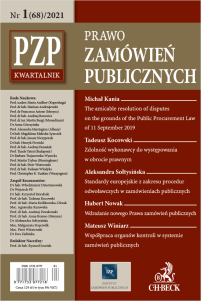
In the latest issue of the C.H. Beck Public Procurement Law Journal, I had the pleasure of discussing issues concerning ''The amicable resolution of disputes on the grounds of the Public Procurement Law of 11 September 2019''.
The new Public Procurement Law of 11 September 2019 explicitly provides for the possibility of using out-of-court means of resolving disputes arising in connection with public procurement contracts. The purpose of the regulation contained in Articles 591-595 is primarily there to increase the attractiveness of the public procurement market in the eyes of the private sector, by creating an opportunity to benefit from a quick and professional settlement of disputes with contracting authorities. The new regulation may also have the advantage of increasing the effectiveness of public procurement. Mediation and conciliation will be the basic methods of amicably resolving disputes arising in connection with public procurement. Despite the fact that the new regulation does not expressly provide for the use of arbitration, the possibility of using it in disputes arising in connection with contracts in matters of public procurement results from the general regulation of Article 1154 of the CCP. The use of ADR in the practice of public procurement is connected with the need to increase competence and knowledge on the part of the ordering parties, and to guarantee an appropriate level of professionalism of mediators, conciliators and arbitrators.
Success of the Faculty of Law and Administration (University of Silesia) Team in the Moot Court "Legal representation before the National Appeal Chamber''
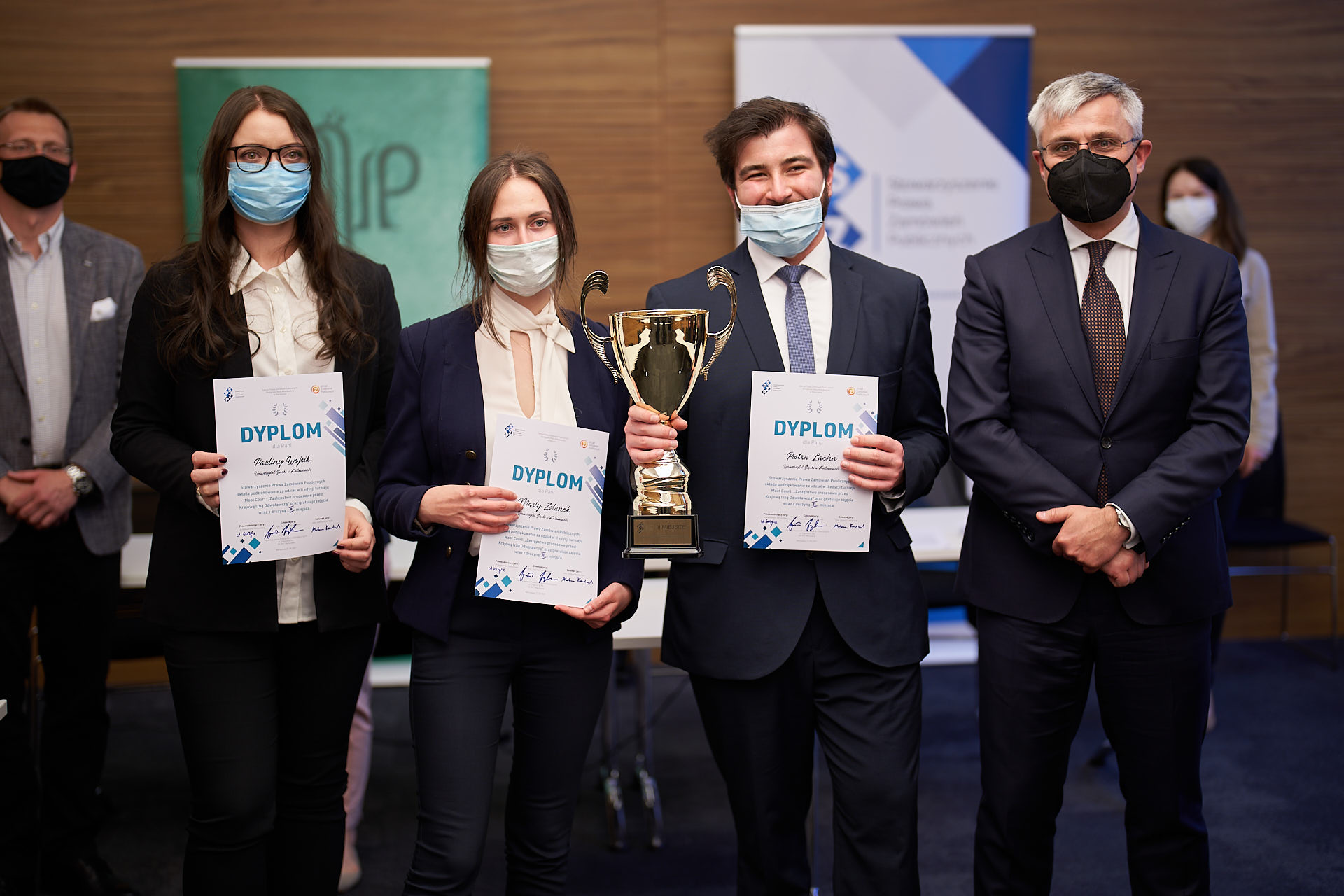
On 21 May 2021 the team of the University of Silesia in Katowice took part in the final round of the second edition of the Moot Court tournament "Legal representation before the National Chamber of Appeal (KIO)". The competition was organized by the Public Procurement Law Association. Honorary patronage over the II edition of the tournament took Hubert Nowak - President of the Polish Public Procurement Office.
The tournament consisted in the simulation of proceedings before the KIO based on the case studies related to the problems of the course of proceedings for the award of public procurement in accordance with the provisions of the new Public Procurement Law of 11 September 2019. In December 2020, preparations for the competition under the supervision of PhD candidate Aleksandra Klefas, and professor Michał Kania, began with a six-person team composed of: Konrad Lach, Piotr Lach, Artur Tyński, Paulina Wójcik, Wojciech Wydmański, Marta Zdunek.
The preparations included a series of 10 seminars devoted to new public procurement law regulations and meetings with practitioners: Agnieszka Piwowarczyk, PhD, Robert Zugaj, attorney, and KIO member Katarzyna Poprawa. The university stage ended with a test of knowledge about public procurement. Piotr Lach, Paulina Wójcik and Marta Zdunek qualified to the final stage.
The representation of the University of Silesia drew the role of the Appellant. Its task was to lead to the repeal of unfavorable for the client provisions of the terms and conditions of the contract prepared by the Employer, which limited access to participate in the procedure. In the final of the competition, which took place in Warsaw, the University of Silesia team won the second place.
The Public procurement role in the support of the Polish National Recovery Plan
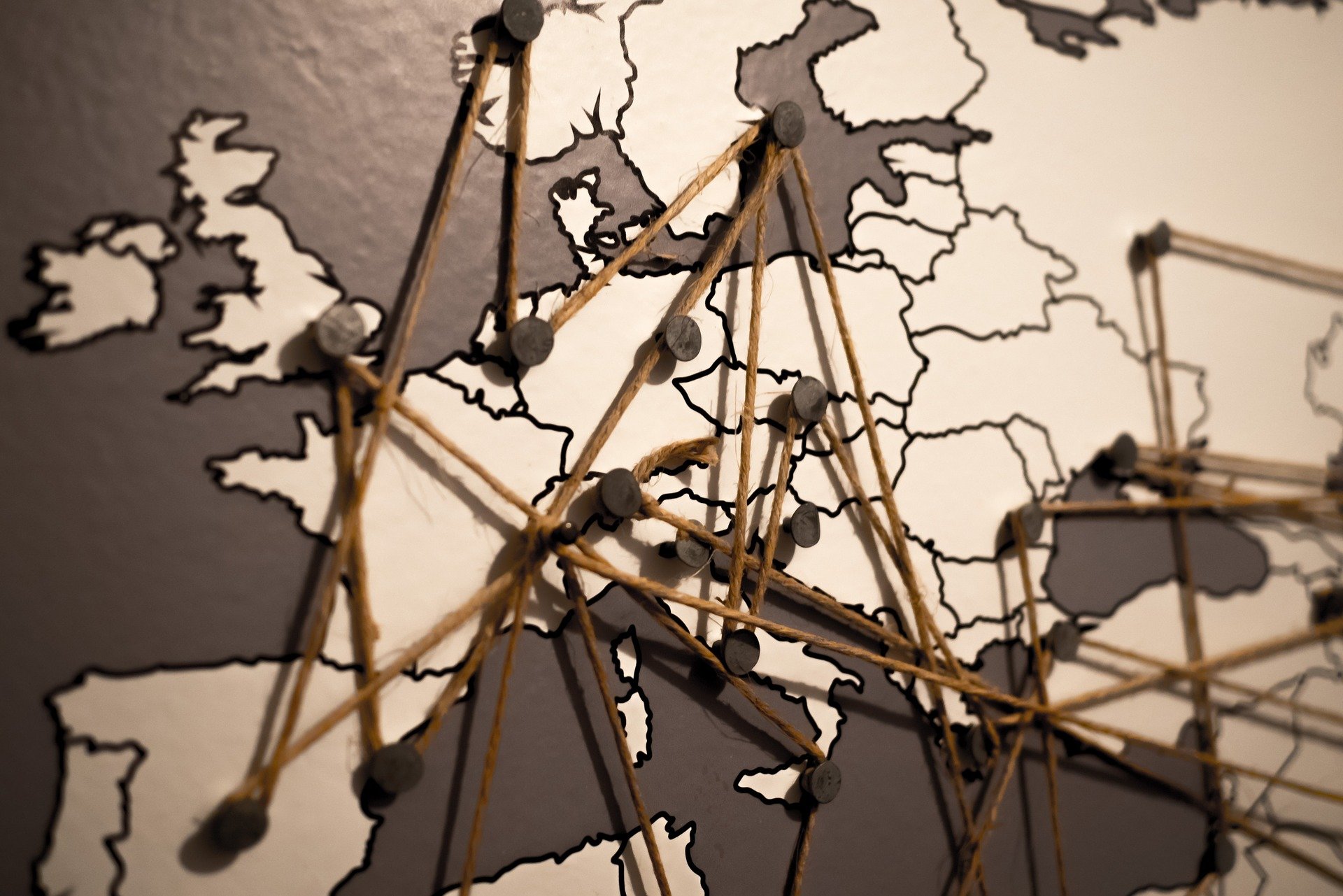
The Recovery and Resilience Facility (RRF) was established on 16 August 2020 within the European Commission’s Secretariat - General. It provides the legal basis for the historic Covid-19 reconstruction. The RRF entered into force on 19 February 2021 and is the key instrument at the heart of NextGenerationEU, the EU's plan for emerging stronger from the COVID-19 pandemic. For the first time ever, the EU is incurring debt to help member states recover financially from the pandemic. The Recovery and Resilience Facility will make 750 billion euro. It includes 390 billion euro of subsidies and the possibility of supplementing them with loans up to another 360 billion euro.
The aim is to mitigate the economic and social impact of the coronavirus pandemic and make European economies and societies more sustainable, resilient, and better prepared for the challenges and opportunities of the green and digital transitions. The specifications are clear: 37% of the money must be invested in climate protection measures, 20% in digital restructuring, the rest in welfare system reform, or in the public health care sector. Due to the RRF provisions countries must present their plans to the European Commission by the end of April 2020. Then the Commission will have two months to evaluate them.
The Polish National Recovery Plan has been elaborated in late April 2021. It assumes several crucial challenges and goals, important for the development of Poland, including green and digital transitions. The huge amount of money will be spent under the procedure foreseen in the public procurement act. This important for contracting authorities legal regulation encompasses crucial methods relevant for achieving of the EU and National Recovery Plan goals. Public procurement act shall be implemented in the proper and efficient way, which was not the case of the Polish practice in the recent past. The Polish public procurement market shortcomings related among others to the low level of competition, lack of strategic goals implementation, and lack of cooperation between public and private sectors. The high expectations are connected with the implementation of the new Polish public procurement act, which came into force on 1 January 2021. This modern regulation offers wide range of legal instruments, which allow contracting authorities to obtain goals of National Recovery Plan. A few things must although be changed.
The Polish National Recovery Plan

On Monday, May 4, 2021 the Polish National Recovery Plan was sent to the European Commission in Brussels. The nearly 500 pages included the amounts and how to spend them in five areas: building economic competitiveness, green energy, digitalization, health care and e-mobility. The Polish National Recovery Plan is a part of the EU Recovery Fund. Poland is one of the biggest beneficiaries of the program. To launch the EU Recovery Fund, all EU countries must ratify the decision to increase the EU's own resources. The repayment of loans is to be made possible by new taxes and levies, including a financial transaction tax, a tax on digital giants, a levy on plastics and a border carbon tax. The Polish Act to ratify the decision to increase EU own resources has been adopted on Tuesday (May 5, 2021).
The assumptions of the EU Recovery Fund were based on two key documents, the New European Green Deal EU Green Deal and the New Industrial Strategy of the European UnionEU Industrial Strategy. The new European Green Deal was presented by the European Commission in December 2019. It sets out to build a sustainable EU economy by seeing climate and environmental challenges as opportunities for growth in all policy areas and delivering a transformation that is fair and inclusive. The New European Green Deal applies to all sectors of the economy, but in particular to: transport, energy, agriculture, construction and industries such as steel, cement, ICT, textiles and chemicals. The green aspects play the crucial role in Poland, one of the most polluted country in the EU. An overwhelming majority of research and reports indicate the necessity of rapid actions in the field of climate changes. It is worth to look at the Intergovernmental Panel on Climate Change (IPCC) special report on the impacts of global warming of 1.5°C above pre-industrial levels and related global greenhouse gas emission pathways, in the context of strengthening the global response to the threat of climate change, sustainable development, and efforts to eradicate poverty. This report highlights several climate changes impacts that could be avoided by limiting global warming to 1.5°C compared to 2°C, or more. For instance, by 2100, global sea level rise would be 10 cm lower with global warming of 1.5°C compared with 2°C. The likelihood of an Arctic Ocean free of sea ice in summer would be once per century with global warming of 1.5°C, compared with at least once per decade with 2°C. The report finds that limiting global warming to 1.5°C would require “rapid and far-reaching” transitions in land, energy, industry, buildings, transport, and cities. Global net human-caused emissions of carbon dioxide (CO2) would need to fall by about 45 percent from 2010 levels by 2030, reaching ‘’net zero’’ around 2050. This means that any remaining emissions would need to be balanced by removing CO2 from the air . The Paris Agreement adopted by 195 nations at the 21st Conference of the Parties to the UNFCCC in December 2015 included the aim of strengthening the global response to the threat of climate change by “holding the increase in the global average temperature to well below 2°C above pre-industrial levels and pursuing efforts to limit the temperature increase to 1.5°C above pre-industrial levels’’.
The New Industrial Policy was presented in turn by the European Commission in March 2020. This policy is cross-cutting in nature and aims to provide framework conditions that foster competitiveness in industry. The policy is based on two pillars: climate neutrality and digitalization. It is also linked to a number of EU policies, such as trade, internal market, research and innovation, employment, environment, and public health. On March 9, 2021, the Commission presented a vision and direction for digital transformation in Europe by 2030. According to the presented document, by 2030 in the EU, among others, at least 80 percent of all adults should have basic digital skills and there should be 20 million employed ICT specialists, with more women in such professions. In addition, by 2030 all EU households should have a gigabit connection and all populated areas should be covered by a 5G network. The production of state-of-the-art and sustainable semiconductors in Europe should account for 20 percent of global productionEU explores chipmaker alliance in search of ‘strategic autonomy’ – EURACTIV.com.
The Polish National Recovery and Resilience Plan is a policy document that sets out the goals for recovery and building socio-economic resilience in Poland after the Covid -19 pandemic crisis, the structural reforms, and investments. The time horizon for the implementation of the document closes at the end of August 2026. Under the Polish NRP more than euro 23.9 billion in grants and more than euro 34.2 billion in loans are to go to Poland. The addressees of the proposed Polish NRP activities are among others: a) entrepreneurs and enterprises, who will receive funds to diversify their business profile and restoration of investments, both in sectors most affected by the consequences of the pandemic (e.g. the sector of tourism, culture, catering and trade) and new investments to develop the potential for innovation, electromobility, deployment of green technologies and products, and development of applications and services in digitization; b) local governments, receiving support, inter alia for investments in infrastructure development and means of transport, ensuring clean environment and new investment opportunities (e.g. implementation of the planning and spatial development reform, preparation of investment sites thermal modernization of schools, sewage treatment systems and water supply outside agglomerations, green agglomerations, green transformation of cities (including small and medium ones) and their functional areas, digital school infrastructure, zero-emission bus fleet), c) public institutions providing basic social services (health, education, labor market), determining the quality of life and development prospects of Poland. Poland's main development challenges include the growing pressure on the public finance system to ensure financing of public investments, the reduction of investment capacity of local governments. The phenomena that emerged because of the Covid -19 pandemic should be seen against the background of other structural weaknesses of the Polish economy, which have a negative impact on the level of competitiveness and productivity indirectly, in the longer term, determine the prospects for growth in the level and quality of life of the population. These include among others: low demand and inadequacies of the innovation implementation system, infrastructure gap in transport, energy, and digital infrastructure. As a starting point for defining the areas of intervention in the form of reforms and investments within the Polish NRP nine key strategic challenges - that Poland faces - have been identified in order to provide support the society and economic sectors affected by the consequences of the pandemic, as well as to use the current crisis to accelerate modernization processes and transform the economy based on new development factors not related to the price of labor and fossil fuels.
The nine key challenges are as follows:
- The productivity level of the economy - the ability to create high quality jobs under conditions of a transforming economy
- Adverse demographic trends and labor supply
- Investment climate and level of private investment
- Decoupling from coal and transforming key sectors of the economy to a low-carbon model
- Digital transformation of the economy
- Inadequate quality and limited access to health services and the ability to rapidly health system response to epidemic threats
- The state of infrastructure, structure, and safety of transport for a competitive green economy and smart and intelligent mobility
- Concentration of development and climate problems, loss of growth potential and low resistance to crisis phenomena in the territorial system
- Ensuring sustainable public finances
The Polish government is planning to undertake a few key reforms and accompanying investments that will make it possible not only to overcome the pandemic crisis, but also to speed up the transformation of the Polish and European economies and to increase the living standards of Poles. In order to achieve the objectives, set out in the Polish NRP by August 2026 it is planned to spend the entire sum of non-returnable resources available to Poland within the Funds in the amount of EUR 23.858 billion (approx. PLN 109 billion). The reforms envisaged in the Polish NRP also require additional support from the loan part of the Fund. At the time of submitting the NRP to the European Commission, Poland will apply for euro 12.112 billion (PLN 55 billion) from the loan part. Thus, a total of EUR 35.970 billion (PLN 164 billion) of the available euro 58 billion (PLN 264 billion) is planned to be spent under the Polish NRP. Based on the vision of national development formulated in the Polish Strategy for Sustainable Development , taking into account the effects of the pandemic and the objectives formulated at the EU level, including the basic assumptions and requirements of the RRF instrument, the following specific objectives of the Polish NRP have been adopted:
- qualitative, innovative development of the economy leading to increased productivity, considering the digital transformation of the country and society;
- green transformation of the economy and the development of green, smart mobility;
- increase of social capital and quality of life, by ensuring improvement of the health condition citizens and higher quality of education and skills adjusted to the needs of modern economy.
According to the Polish NRP most of the funds will go to the Green Energy and Reduction of Energy Consumption component - euro 5.7 billion from the grant part and euro 8.6 billion from the loan part (a total of euro 14.3 billion), as well as to the Green, Intelligent Mobility component - euro 6.8 billion from the grant part and euro 0.7 billion from the loan part (a total of euro 7.5 billion). This represents 39.8% and 20.9% of the total funds planned for spending under the Polish NRP, respectively. Euro 4.5 billion from the grant part and euro 245 million from the loan part (a total of euro 4.7 billion), representing 13.1 percent of the NRP, are to be allocated for the implementation of the other components of the Resilience and Competitiveness of the Economy. Investments from the part Efficiency, accessibility and quality of healthcare system will absorb euro 4.1 billion from the grant part and euro 450 million from the loan part (in total euro 4.5 billion), which constitutes 12.6% of funds that Poland plans to spend. The last part of the plan, entitled Digital Transformation, will be allocated euro 2.797 billion from the grant part and euro 2.100 billion from the loan part (a total of euro 4.897 billion), representing 13.6 percent of the funds planned to be spent under the Polish NRP.
The public procurement role in the achievement of the Polish NRP goals

Public procurement plays a special role in the implementation of the objectives contained in the Polish NRP. It is pointed out directly in the document, which states among others that the role of the public procurement will relate to the:
- increasing of the competitiveness on the public procurement market and increasing access to the market procurement market for small and medium-sized enterprises,
- identification of strategic procurements and those procurements that are innovative,
- managing of the entire purchasing process, improving the system of appeals, the system of control, allowing for better identification of contracts that have an innovative character,
- the amendment to the Act on Electromobility, aimed at increasing the required share of green vehicles in public procurement. Implementation of this task will be done through a statutory obligation for larger cities to procure electric and hydrogen buses only. In accordance with Poland's Energy Policy until 2040, in cities with population over 100,000 In accordance with the Polish Energy Policy until 2040, each tender for the purchase of buses intended for public transport purposes as of 2025 should include only zero- and low-emission buses (electric and hydrogen). The planned solution assumes the introduction from 2025 of the obligation to award transport contracts only to entities offering this type of vehicles.
- applying of Green Public Procurement rules in projects which will be financed from the EU budget,
- all healthcare entities implementing investments from Polish NRP will be required to perform tasks in accordance with Public Procurement Law,
- further digitalization of the public procurement process,
- counteracting conflicts of interest and corruption cases
The importance of public procurement results from its potential shaped by two factors. First, the number of entities obliged to apply public procurement regulations (ca. 13. 000 contracting authorities in Poland). Secondly, the amount of funds spent based on the public procurement procedure. The role of public procurement in achieving the goals envisioned in the Polish NRP stems from several reasons. Firstly, public procurement has a key impact on the availability and quality of certain supplies, works and services for the public sector. This is because public procurement involves the purchase of specific products, works or services which may, to a greater or lesser extent, meet the criteria provided for in the Polish NRP. It is worth noting that some of the procurements will be made in the interest of the contracting authority, while the majority will be made in the interest of the recipients of services provided by the public sector. Areas such as public transport, public buildings, health care carry a burden of responsibility for the contracting authorities towards the beneficiaries (public interest). Current national data on purchasing innovative and environmental products and services are not encouraging. According to the Report of the President of the Public Procurement Office for the year 2019 (Polish version), innovative aspects (together with environmental aspects) were included in only 3% of expenditure measures under Polish public procurement procedure. Innovation partnership - a mode of awarding a public procurement contract based on meeting the demand for an innovative product, service, or work if it is not available on the market was, in turn, not used at all.
Secondly, public procurement can be seen as a method of stimulating the supply of specific desired solutions, including pro-environmental and pro-innovative ones, through incentives directed to entrepreneurs, especially representatives of the SME sector, capable of delivering them. This sector should play a decisive role in the light of the provisions of the Polish NRP in the post pandemic area. A stable public sector that sends a clear signal to the private market, indicating a demand for modern (eco) technologies, should result in the development of entrepreneurs who are ready to cooperate with public entities.
Thirdly, public procurement can provide a platform for the activation of specific social groups through so-called "reserved procurement’’. These procurements encompass public procedures to sheltered workshops and economic operators whose main aim is the social and professional integration of disabled or disadvantaged persons. This will perfectly fit in with challenge 2 - Adverse demographic trends and labor supply - regarding workers associated with the coal mine industry. The reserved procurement may play an important role in the Just Transition Mechanism JTM. The Just Transition Mechanism is a key tool to ensure that the transition towards a climate-neutral economy happens in a fair way, leaving no one behind. It provides targeted support to help mobilise at least euro 150 billion over the period 2021-2027 in the most affected regions, to alleviate the socio-economic impact of the transition.
Fourthly, the public procurement environment – organization of contracting authorities sector - itself should have a high level of new model approach. There are at least two areas, which are relevant in this context: the electronisation of the purchasing process and technological support for public procurement at the contract preparation and execution stages. It is therefore desirable for public procurement to make use of, among other things, technological tools influencing the way in which the implementation of public procurement contracts is monitored. It is important to use modern technologies at the stage of preparation and realization of public investments. These include augmented and virtual reality used in design and construction or building information modeling systems (BIM). It is also important to use technology to monitor the stages of investment implementation, e.g. by using drones or sensors at the site of construction works to control the materials used. Modern technologies enable comprehensive supervision of design, contracting, construction and operation of public investments. They also affect the reduction of costs or delays in the implementation of investments. Moreover, the integrated use of technological tools can improve the transparency of processes leading to the award of public contracts, the processes of concluding and modifying procurement contracts, payments to contractors and subcontractors, and the elimination of corruption.
The development of the Polish public procurement regulation and required actions

The first Polish public procurement act, after the communism era was adopted on June 10, 1994. It came into force on January 1, 1995 and it fact brought back the special regulation concerning spending public money in Poland after 50 years. It is worth mentioning that Poland after the WW2 did not implemented the complementary regulation concerning public procurement. It did not also implement other legal and economical constructions based on New Public Management or Good Governance doctrines.
The public sector based on authoritative approach in relations with private sector using in most cases administrative decision. The providing of public tasks has been entrusted into stated-own enterprises, which created the still present way of ,,in house’’ procurement. The lack of the serious negotiations between public and private sector has been seen during many next years after communism collapsed in 1989. The regulation from 1995 has been modify many times particulary in time when Poland was accessing European Union. Before joining the EU Poland has adopted the Act of 29 January 2004 on public procurement. This regulation was one of the most amended legal act in Poland.
The biggest reform of it took place in 2016, when Poland implemented into this act the two EU Directives it means: Directive 2014/24/EU of the European Parliament and of the Council of 26 February 2014 on public procurement and the Directive 2014/25/EU of the European Parliament and of the Council of 26 February 2014 on procurement by entities operating in the water, energy, transport, and postal services sectors. The third EU Directive 2014/25/EU of the European Parliament and of the Council of 26 February 2014 on the award of concession contracts has been implemented as a separate act of 21 October 2016 on concession contract for works or services.
The Polish public procurement market faces many problems. One of the biggest and crucial concerns the level of competition. Even though the open procedure plays the main role as a solicitation method, the average of bids in the Polish procedure is exceptionally low. In the procurement there were averagely 2.42 of bids. It is worth mentioning that in 43% of the procurement the only one bid was made. The above indicated numbers tells of extremely low interest in achieving contracts on the Polish public procurement market. The low numbers of the competitors result in limited access to the newest solutions, including innovative and green technology. Another alarming fact concerns the number of foreign entrepreneurs performing public procurement in Poland. Although Poland is the leading country within new EU member states, with the 42% of the contracts notices made in the EU Publication Office, only 3% of the procurements goes to foreign contractors. There are a few reasons for the private sector’s little interest in the Polish public procurement market. The main relates to the weak position of the contractors in the contract. The common solution, implemented by the contracting authority assumes the transfer of risks on the contractors side. It results not only in low interest but also in the increasing of the prices proposed by the contractors. Another problem is also connected with the reservation of high liquidated damages, which are not proportional to the contractors activity. In practice also this stipulation results in the increase of the prices and the contractors discouragement for the cooperation with the public sector. The public procurement in Poland also does not guarantee the assurance of the financial liquidity, particulary for the small and medium enterprises. All above mentioned factors result in an uncomfortable contractors position within Polish public procurements. The risks of the performance are remarkably high while the guarantee of the economic stability is exceptionally low.
Another problem concerning the low level of the competency relates to the lack of the cooperation between public and private side – implementation of the win-win rule. It results in the omission of the contractors needs and in serious loss of the chances for obtaining the latest industry achievements. Meanwhile the cooperation between sectors might be achieved using few legal measures foreseen in both planning and awarding phases of the procurement. In both phases public sector shows sound negligence. In the planning phase the Polish contracting authorities use only in 0.14% of the preliminary market research. As the result the specifications are prepared in the way, which do not consider the needs and proposals of the contractors. Another chance for the contracting authority to cooperate with the contractors give the solicitation methods, which base on negotiation. Also, this possibility has been regularly avoided by the public sector. The use of negotiations methods is Poland is extremely low and stands in ca. 1% of the procurements. The mostly used solicitation methods since the beginning of the public procurement regulation has been open procedure (88.97%). In theory this method should guarantee in the best way the competition between contractors. As it has been observed in Poland it is not. It is worth to mention that the second most common solicitation method in Poland is single source. Single source has been used in 8,65% of the Polish procurements. This high level of single source’s usage relates to the implementation of the ,,in house’’ model, which is still common in Poland. The strong lobby for this way of providing services and constructions in Poland results often in extremely poor quality and blockade of the private enterprises in many sectors, which can grow because of the sound competition.
The incredibly low level of the use of negotiations methods in Poland comes from two main reasons. First is the lack of negotiations abilities on the public side. Several dozens of years when the Max Weber’s doctrine dominated in Poland as well as the negligence in the implementation of the New Public Management and Good Governance model after 1989 results in serious dysfunctions in the whole public sector. They are also visible in the lack of cooperation between public and private sector. The other problem relates to the contracting officer fear of the control’s results, which might accuse the improper relations between contracting officer and the representant of the private sector. The application of the legal solutions contained in the Public Procurement Law of 24 January 2004 did not lead to the promotion of technological and ecological development, which are crucial in the light of Polish NRP.
One of the main weaknesses of the domestic public procurement market has been the low level of cooperation between contracting authorities and contractors. In principle, the private sector is much better prepared to produce and deliver advanced technologies and environmental solutions than the public sector does. However, to unlock and exploit the potential of the private sector, cooperation is required from the very beginning. Meanwhile, according to the Report of the President of the Public Procurement Office for 2019, the rate of market consultations prior to the initiation of public procurement proceedings amounted to 0.14% of the announced proceedings. At the same time only 333 contracting authorities, out of a total of 13.000 applying the public procurement act, have awarded environmental contracts. All the discussed aspects demand the new approach to the Polish public procurement regulation. The current implementation of the public procurement act leaves Poland with no doubts outside the mainstream of the fast public development and shows great challenges in the NRP implementation. It also weakens the whole region leaving it for solutions disingenuous to the contemporary global challenges.
The new Polish public procurement act

The huge gap between government ambitious and reality demanded big changes in the Polish public procurement regulation. These changes have been reflected in the new Polish public procurement act of 11 September 2019. The preparation of the new act started in 2016. It was the direct result of the implementation of the governmental ‘’Strategy for the responsible development’’ adopted in February 2016 (Polish version). This policy act foreseen among other things the creation of the pillar called ‘’Smart public procurement’’. At the beginning of the discussion about the form of the new regulation there was the question concerning the scope and the depth of the further changes.
Considering a very retarded situation of the Polish public procurement market it was agreed that the changes must be profoundly serious. In assumptions the new regulation shall help Poland to modernize the public procurement market. The new law entered into force on January 1, 2021. The constructs contained in this act may contribute to the realistic implementation of the goals envisioned in the Polish NRP. For this to happen, it will be necessary to base Polish public procurement on several essential pillars. These include inter alia: basing contracting authorities’ actions on the principle of efficiency, increasing communication between contracting authorities and contractors, increasing competition in the domestic public procurement market, increasing the use of technologically and environmentally advanced solutions in the procedure of awarding and implementing public procurement contracts.
The implementation of the concept of strategic procurement, based on the principle of efficiency, is of the key importance for achieving the required goals. This means considering other aspects besides price in the public procurement process, including environmental, social, and economic effects. This principle has been provided for in article 17(1)(2) of the new public procurement act. The new solution assumes obtaining the best results of the contract, including social, environmental, and economic effects, if any of these effects is possible to achieve in each contract in relation to the expenditures incurred. Economic effects should be understood broadly and include also technological aspects. The implementation of the new rule will play an important role for the Polish practice. First, this written rule will be the biding norm in every purchase made by use of public money (including EU funds). Second, it will justify the choices which will depart from the simple award based on the lowest price without consideration of green and social aspects. It is the qualitative change in the reality of the Polish practice approach, in which the important role plays the controlling authorities based on wording interpretation of the legal text. Since the adoption of the effectiveness rule there is no doubt that contracting authorities shall achieve other aims that only spending the last amount of public money.
In the assumption the adoption of the effectiveness rule shall decrease the fear of the controls result for the creative contracting authorities. The new legal structure provided for in article 21 of the public procurement law will also play an important role in actual implementation of the principle of effectiveness. It requires the Council of Ministers to adopt a four-year national procurement policy. The purchasing policy should define the priority activities of the Republic of Poland in public procurement, as well as the desired direction of contracting authorities' actions with respect to contracts awarded, which includes the purchase of innovative or sustainable products and services and other aims foreseen in the Polish NRP. This policy should therefore directly address the need to consider aspects related to environmental and technological development, providing an important signal for the development of the domestic private sector. It is also worth pointing out the new construction of the so-called analysis of the needs of the contracting authorities, referred to in article 83 of the new act. This analysis should consider the needs of contracting authorities relating to, among other things, innovative and environmental aspects. This action shall promote the contractors, which are ready to deliver the required standards. Another prerequisite for the effective use of public procurement to support the objectives of the Polish NRP will be increasement of the communication between contracting authorities and contractors. The public sector should make much wider use of solutions that enable cooperation with the private sector at each stage of the procurement process, including preparation of the procedure, selection of the most advantageous offer, and implementation of the contract.
At the stage of preparing the procedure it would be desirable to implement a mechanism of preliminary market consultations, referred to in article 84 of the new act. Preliminary market consultations are aimed at using the knowledge of experts as well as contractors to obtain information on the current state of technological development and possible applications of demanded in the Polish NRP solutions in the context of the contracting authority's needs. With the current rapid development of technology, the use of pre-market consultations by contracting authorities seems to be essential to meet the Polish NRP goals. In the context of the private sector, the use of market consultations will also allow economic operators to adapt their existing or envisaged solutions to current and future contracting authorities' needs.
At the stage of selecting the most advantageous offer, contracting authorities should make much wider use of negotiated procedures than they do now, both in the case of domestic contracts and contracts above the EU thresholds. In this aspect, attention should be paid to the solutions referred to in article 275(2) and (3) of the new public procurement law. Two newly introduced procedures in the so-called domestic procurements are based strictly on negotiations. In the light of article 275(2) the contracting authority may conduct negotiations to improve the content of tenders subject to evaluation based on tender evaluation criteria, as long as it has provided for such possibility, and after the negotiations are completed, the contracting authority invites economic operators to submit additional tenders. On the other hand, in the situation provided for in article 275(3), the contracting authority conducts negotiations to improve the content of tenders, and after the negotiations are completed, the contracting authority invites contractors to submit final tenders. Both above procedures give the parties to public procurement contracts the opportunity to agree on key technological aspects. For contracts above the EU thresholds, the use of negotiated procedures, including competitive dialogue, negotiation with publication and innovation partnership, should be expanded. Also, under these procedures it will be possible to work out common solutions considering the expected solutions. The crucial meaning for the contractors situation shall have the new regulation concerning contracts. First there is a mandatory provision in article 433, which limits the number of liquidated damages, the scope of contractors responsibility. Second the new regulation implements the mandatory advance payments and partial payments.
The post pandemic situation will be created mostly by the implementation of the European Recovery and Resilience Facility - the EU's plan for emerging stronger from the Covid -19 pandemic. The parts of this program are national recoveries plans. The Polish one has been adopted in the end of April. The crucial for the implementation of the ambitious goals plays public procurement – procedure for the spending of public moneys on new epochal aims. The current state of the Polish public procurement implementation with the exceptionally low level of competition on the market does not accede to the global contemporary challenges, also these envisaged in the Polish National Recovery Plan. It promotes the simple, cheap solutions, for which contracting authorities pay excessive prices. The awarded offers do not comply with the green and innovative standards of global development. The SME are not interested in cooperating with the public authorities losing the chance for the faster development and growth.
The challenges posed in the Polish NRP require a fundamental change in the approach of contracting authorities. An opportunity for such action is provided by the new Polish public procurement act, which came into force on 1 January 2021. The solutions included in this act enable the sharp increase of technological and green aspects in the Polish public procurement. Used well, they should lead to a significant increase in cooperation between the public and private sectors. This in turn shall result in increasing competitiveness, quality of deliveries, works and services in connections with the implementation of the European Recovery and Resilience Facility, as well as Polish National Recovery Plan.
The public procurement role in the digital transition

The current challenges facing the public sector, both at the national and EU level, cover several aspects. In a long-term perspective, these challenges relate primarily to issues of technological (digital), environmental transformation and geostrategic issues. From the public procurement perspective digital transformation includes activities centered around the use of modern technologies based on the 4th Industrial Revolution, Internet of Things, 5G network, Blockchain and the Smart City concept. Environmental transformation is implemented primarily to achieve the Paris Agreement concluded in 2015. At that time, during the climate conference in Paris (COP 21), an agreement was adopted which assumes a series of actions aimed at stabilizing global warming at a level below 2ºC. This level is calculated in relation to the level from the pre-industrial era. Reaching this level will help to avoid exceeding important critical points of the Earth's climate system. The geostrategic aspect in turn raises the question of effective cooperation between the European Union and the leading world economies, i.e. the Chinese and American. Of particular importance is possible cooperation between member states and China under the New Silk Road initiative. This concept, also called the Belt and Road Initiative, was presented by the President of the People's Republic of China - Xi Jinping in 2013. Development based on modern infrastructure that takes advantage of technological advances is one of the cornerstones of China's Belt and Road Initiative. The political and geopolitical implications of technological development are now becoming increasingly apparent. There is a perceptible shift away from the unquestioned technological supremacy of the United States to a much more fragmented global landscape with a more unpredictable foreign policy reality in which state and non-state actors compete for influence and digital competencies become more important than ever. We are becoming witness to a digital arms race in which not only China and the United States, but also their technology giants, will compete for global dominance. It is worth pointing out in this context the emergence of new institutions aimed at mobilizing or facilitating the financing of infrastructure based on modern technologies, such as the Asian Infrastructure Investment Bank (AIIB), the New Development Bank, the Global Infrastructure Fund and the Global Infrastructure Hub. The indicated institutions offer interesting solutions for public sector entities to leapfrog civilization with modern technologies.
Both at the EU and national levels, we are witnessing increased efforts to develop strategies that will allow the economy to adapt its development to the current challenges. The strategy of the new European Commission assumes two pillars of economic transformation: environmental and digital transition. In this regard, the European Commission has prepared new public policies to define the place of the European Union in the dynamically changing global system. The directions of development of the EU economy have been included in two fundamental acts, i.e.: the New European Green Deal and the New Industrial Strategy of the European Union. The New European Green Deal was presented by the new European Commission in December 2019. It sets out to build a sustainable EU economy by seeing climate and environmental challenges as opportunities for growth in all policy areas and delivering a transformation that is fair and inclusive. The New European Green Deal applies to all sectors of the economy, but in particular to transport, energy, agriculture, construction and industries such as steel, cement, ICT, textiles and chemicals. The New Industrial Policy was presented by the European Commission in March 2020. The policy is cross-cutting in nature and its objective is to ensure framework conditions conducive to industrial competitiveness. It is also linked to many EU policies, e.g. trade, internal market, research and innovation, employment, environment and public health. In particular, EU industrial policy should aim to: accelerate industry's adjustment to structural change, foster an environment favourable to initiative and to the development of enterprises throughout the Union, especially small and medium-sized enterprises, foster an environment favourable to cooperation between enterprises, and encourage better use of the industrial potential of innovation, research and technological development policies.
New Industrial Strategy for Europe uses the concept of digital transformation. Analyzing the content of this Strategy, as well as the Communication on "A vision and direction for digital transformation in Europe 2030" announced on March 9, 2021, it seems that the term "digitalization" should be understood comprehensively. It becomes a starting point for the creation of a specific ecosystem of digital solutions connected with a wide use of modern technology and related products, services and infrastructure. Digitalization concerns issues related to the acquisition of modern technologies in the context of supplies, services or works carried out by the public sector through procurement. This aspect is of key importance and refers to several issues linked to the concept of digitization including: 4th Industrial Revolution, Internet of Things, 5th generation mobile network (5G), Blockchain and binding all the above phenomena into one - the concept of Smart City. The 4th Industrial Revolution refers to the development of new information technologies such as artificial intelligence, automation, robotics, which have an impact on conventional economic models. 4th IR is driven by a wide range of technology trends interacting with each other to create an exponential economic, social and political transformation. Soon, embedded sensors and distributed computing power-the so-called Internet of Things-will be connected by ubiquitous fifth-generation wireless networks (5G networks) to create an unprecedented amount of digital data, stored conveniently in the global cloud. Artificial intelligence (AI), driven by high-performance computing (HPC) systems, will in turn allow data to be analyzed and interpreted, yielding a wealth of previously inaccessible information. It will also enable the creation of new systems that can ingest, process and respond to this information at the speed of a machine. In this context, we can therefore speak of an existing technology ecosystem - a series of interconnected product, service and infrastructure solutions based on digitization.
The risk concerning the dynamics of implementation of the 4th Industrial Revolution is based on the assumption that many public institutions will continue to prefer the reliance on traditional industry, ignoring the changes that dynamically create the future. This threat relates in particular to the sector of public procurers who, as market data indicates, absorb modern solutions much more slowly than the private sector. This applies both to the organizational sphere and to the technological advancement of products and services purchased. Digitalization affects the public sector in the context of public procurement in two ways. Firstly, it affects the purchasing processes themselves, referring, among other things, to the issue of the digitalization of public procurement. Secondly, digitalization concerns issues connected with the acquisition of modern technologies in supplies, services or construction works realized by the public sector through public procurement. The second aspect is of key importance. Public procurement will play an important role in the implementation of modern solutions. They have the potential to implement digital transformation due to the number of entities obliged to use adequate legal regulations and the amount of funds spent annually on public procurement. This aspect is explicitly pointed out in the New Green Deal. The New Green Deal stresses that public sector entities, including the EU institutions, should set an example and ensure that their public procurement is environmentally friendly. At the same time, the European Commission was obliged to propose new regulations and guidelines for green public procurement. The New Industrial Strategy, on the other hand, underlines that in order to ensure that the EU's mobility sectors remain world leaders in terms of technology, it will be necessary to maintain a leading position in research and innovation, to rapidly put in place the necessary infrastructure, and to introduce strong incentive measures, including through public procurement.
The role of public procurement in supporting technology transformation stems from several reasons. First, public procurement has a key impact on the availability and level of specific technological solutions in supplies, works and services for the public sphere. This is because procurement involves the purchase of specific products or services that may, to a greater or lesser extent, meet the criteria of technological advancement. It is worth noting that part of the procurement will be carried out in the interest of the contracting authority, while the majority will be in the interest of the recipients of services provided by the public sector. In particular, areas such as public transport, public buildings, health care carry a burden of responsibility for the contracting authorities towards the beneficiaries.
Secondly, public procurement can be seen as a method of stimulating the supply of specific technological solutions through incentives addressed to entrepreneurs, especially representatives of the SME sector. A stable public sector that sends a clear signal to the private market, indicating a demand for new technologies, should result in the development of entrepreneurs who are ready to cooperate with public entities. Often a barrier to the development of modern technologies is the risk of their introduction on the market. The risk connected with financing research and product development can be transferred to the public sector thanks to public procurement. In this aspect, the question of redistribution of possible benefits from the implementation and commercialization of these solutions, in the financing of which the public sector participated.
Thirdly, the public procurement environment itself should be highly technologically advanced. In this respect, two areas stand out: the digitalization of the purchasing process and technological support for public procurement at the contract preparation and execution stages. It is therefore desirable for public procurement to make use of, among other things, technological tools influencing the way in which the implementation of public procurement contracts is monitored. It is important to use modern technologies at the stage of preparation and realization of public investments. These include augmented and virtual reality used in design and construction, or building information modeling systems (BIM). It is also important to use technology to monitor the stages of investment implementation, e.g. by using drones or sensors at the site of construction works to control the materials used. Modern technologies enable comprehensive supervision of design, contracting, construction and operation of public investments. They also affect the reduction of costs or delays in the implementation of investments. Moreover, the integrated use of technological tools can improve the transparency of processes leading to the award of public contracts, the processes of concluding and modifying procurement contracts, payments to contractors and subcontractors, and the elimination of corruption.
Recommendation of professor Alexandra Harrington's new book: International Law and Global Governance Treaty Regimes and Sustainable Development Goals Implementation

Prof. Alexandra Harrington is the Director of Studies for the International Law Association Colombian branch, a member of the International Law Association Committee on the Role of International Law in Sustainable Natural Resource Management for Development, and an adjunct professor at Albany Law School. She also provides guest lectures globally on topics related to international law, environmental law, global governance and sustainable development.
Prof. Harrington has served as a consultant for entities such as the Commission for Environmental Cooperation of the North American Agreement on Environmental Cooperation and UN Environment. Prof. Harrington’s publications address a variety of fields relating to international law, including environmental law, legal issues relating to climate change, natural resources regulation, international organizations, international human rights law, international child’s rights, international trade law, corporate social responsibility, and criminal law. Prof. Harrington routinely presents her works at domestic and international conferences.
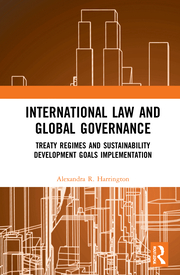
International Law and Global Governance
This book explores the methods through which international law and its associated innovative global governance mechanisms can strengthen, foster and scale up the impacts of treaty regimes and international law on the ability to implement global governance mechanisms.
Examining these questions through the lens of the Sustainable Development Goals (SDGs), the book looks at environmental, social and economic treaty regimes. It analyses legal methodologies as well as comparative methods of assessing the relationship between the SDGs and treaty regimes and international law. Contradictions exist between international treaty regimes and principles of international law resulting in conflicting implementation of the treaty regimes and of global governance mechanisms. Without determining these areas of contest and highlighting their detrimental impacts, the SDGs and other efforts at global governance cannot maximize their legal and societal benefits.
The book concludes by suggesting a path forward for the SDGs and for international treaty regimes that is forged in a solid understanding and application of the advantages of global governance mechanisms, including reflections from the COVID-19 pandemic experience. Addressing the strengths, gaps and weaknesses related to treaty regimes and global governance mechanisms, the book provides readers with a comprehensive understanding of this increasingly important topic. It will be of interest to students, researchers and practitioners with an interest in sustainability and law.
Public Procurement and Public Private-Partnership

Public Procurement and Public Private-Partnership (PPP) are methods, which can support public sector in achieving common golas, such as: sustainability and innovation of public infrastructure. Public procurement and PPP shall respond to the current global challenges such as combat of pandemia, implementation of 4th Industrial Revolution benefits, 5G, building Smart Cities, responding to geostrategic challenges and improving of eco-innovation. The role of academics, both private and public sector is to support the public procurement and PPP in common public mission.
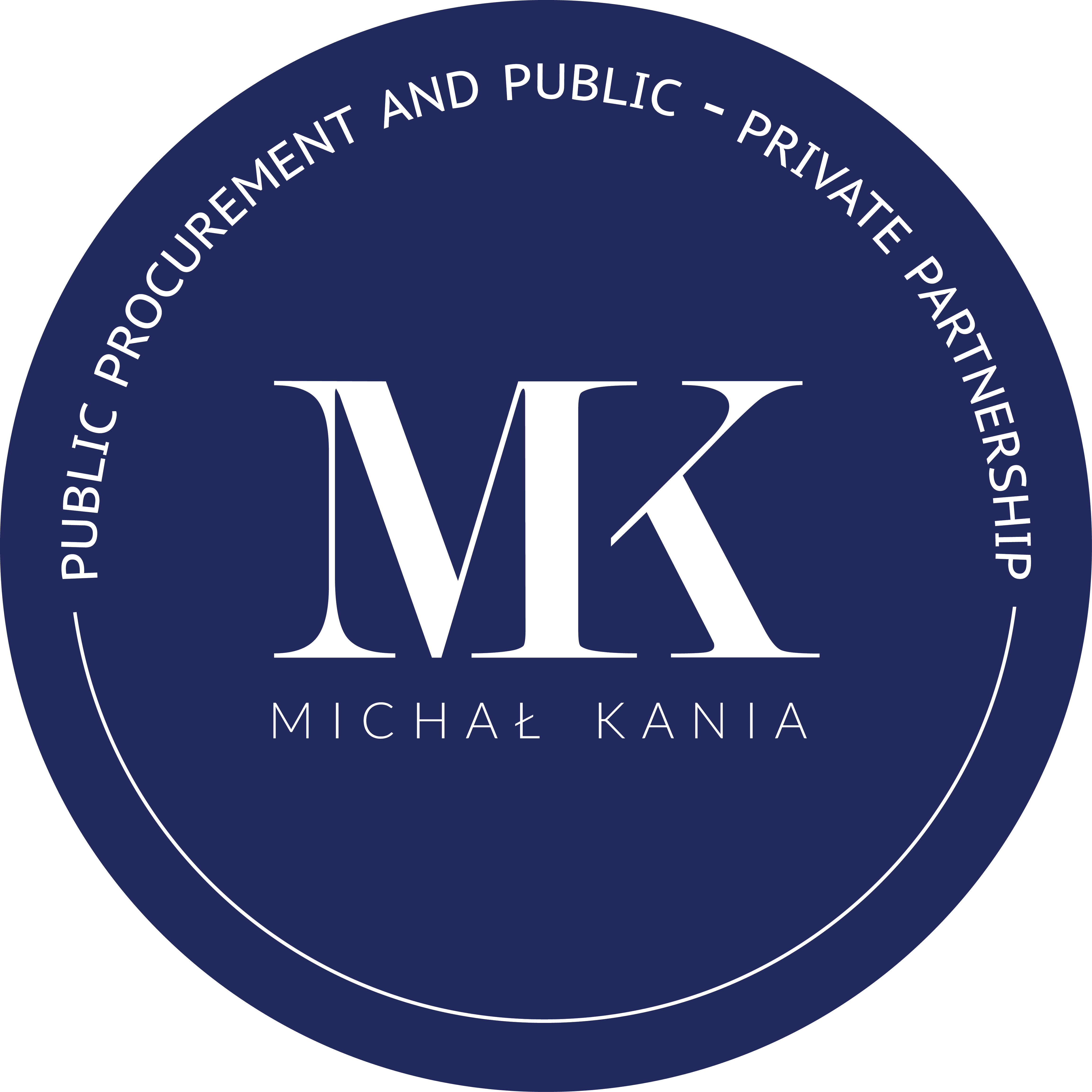
Michał Kania, professor at the University of Silesia in Poland, Senior Researcher at the Centre for Private Governance (University of Copenhagen), legal adviser with 16 years of practical experience in PPP, public procurement and concession contracts, member of the Just Transition Research Group at the University of Silesia. Active member of the Public Procurement Association in Poland, Visiting Fulbright Scholar at the George Washington University (2018-2019), Fellowship of German Academic Exchange Service at the Ludwig Maximilian University in Munich (2017), author of more than 100 publications regarding PPP, public procurement law, administration law and administration procedure, speaker at the Polish and international conferences, initiator and lecturer at the Postgraduate Studies in Public-Private Partnership and Public Procurement at the University of Silesia, founder and the first president of the PPP Academic Support Foundation, founder of the program ‘’PPP- Good Choice’’ (active in years 2009 – 2014), former president of the PPP Commission by the Conference of Rectors of Academic Schools in Poland, independent adviser for the Polish Ministry of Development for the concept of the new Polish Public Procurement Act, adopted on 11 September 2019, plenipotentiary of the President of the University of Silesia for PPP projects, MBA, with the final thesis: ,,Economic and financial analyses in public – private partnership projects’’.